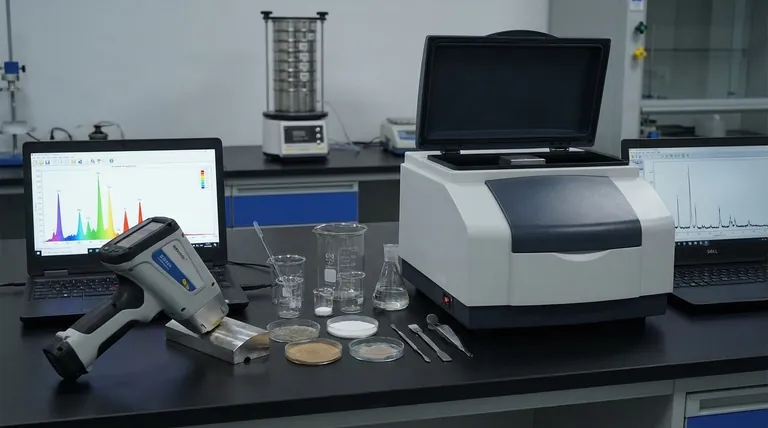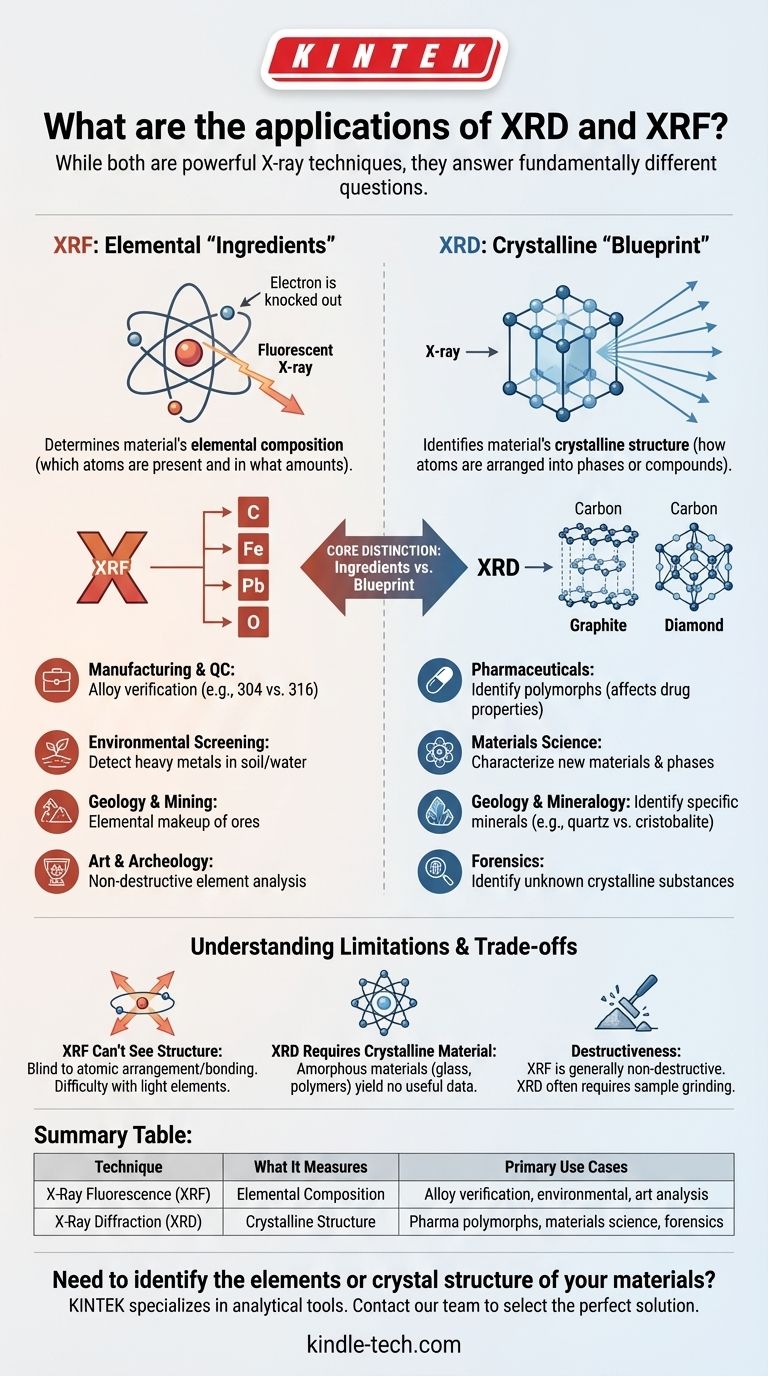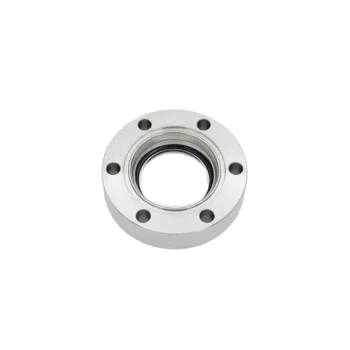XRDとXRFはどちらも強力なX線技術ですが、材料について根本的に異なる問いに答えます。X線蛍光(XRF)は、材料の元素組成を決定するために使用され、どの原子がどれくらいの量で存在するかを特定します。対照的に、X線回折(XRD)は、材料の結晶構造を特定するために使用され、原子が特定の相や化合物にどのように配列しているかを明らかにします。
核心的な違いは単純です。XRFは化学成分のリストを提供し、XRDは建築の設計図を提供します。XRFスキャンはサンプルに炭素が含まれていることを示しますが、XRDスキャンは、その炭素がグラファイトとして配列されているか、ダイヤモンドとして配列されているかを示します。

各技術が実際に測定するものは?
適切なツールを選択するには、まず各技術が利用する物理的原理を理解する必要があります。どちらもX線を使用しますが、サンプルの原子との相互作用の仕方は全く異なります。
XRF:「成分」の特定
X線蛍光は化学分析技術です。これは、サンプルを高エネルギーX線で照射し、原子の内殻から電子を叩き出すことによって機能します。
よりエネルギーの高い殻からの電子がこの空隙を埋めるために降下する際、二次的な「蛍光」X線を放出します。この蛍光X線のエネルギーは元素ごとに固有のフィンガープリントとなり、サンプルの原子組成を正確に特定できます。
XRD:結晶の「設計図」の解明
X線回折は構造解析技術です。これは、結晶性材料(原子が規則正しく繰り返される配列を持つ材料)が入射するX線ビームを予測可能なパターンで回折するという原理に基づいています。
結晶中の原子は三次元の回折格子として機能します。回折X線の角度と強度を測定することにより、特定の結晶構造の固有のフィンガープリントとなるパターンが生成されます。これにより、含まれる元素だけでなく、正確な相や化合物を特定できます。
実用における主要な用途
元素の測定と構造の測定の違いは、科学および産業全体で明確で補完的な用途につながります。
XRFの一般的な用途(元素分析)
元素を迅速に特定できるため、XRFは迅速な化学的検証のための頼れるツールです。
- 製造・品質管理: 金属合金の元素組成の検証。例えば、ステンレス鋼がグレード仕様(例:304対316)を満たしているかどうかの確認。
- 環境スクリーニング: 土壌、水、または消費者製品中の鉛、水銀、ヒ素などの重金属の迅速な検出。
- 地質学・鉱業: 探査中の岩石や鉱石の元素組成を決定し、経済的価値を評価する。
- 美術・考古学: 顔料、金属、セラミックス中の元素を分析し、損傷を与えることなく真贋や産地を特定する。
XRDの一般的な用途(構造分析)
結晶相を特定できるため、XRDは材料が実際にどのように構成されているかを理解するために不可欠です。
- 製薬: 溶解性、安定性、バイオアベイラビリティに劇的な影響を与える可能性のある薬物の特定の多形(結晶形)の特定。
- 材料科学: 新しい材料の特性評価、合金中の相の特定、製造部品の残留応力や結晶子サイズの測定。
- 地質学・鉱物学: 岩石サンプル中に存在する鉱物の正確な特定。XRFは岩石にSiとOが含まれていることを示すかもしれませんが、XRDはそれが石英、クリストバライト、またはトリディマイトのいずれであるかを示します—これらはすべて同じ化学組成を持ちますが、構造が異なります。
- 法科学: 違法薬物、爆発物、または犯罪現場で発見された未知の粉末など、未知の結晶性物質の特定。
限界とトレードオフの理解
どちらの技術も万能ではありません。その有効性は、尋ねている問いに完全に依存します。限界を理解することが、誤った結論を避けるための鍵となります。
XRFは構造を見ることができない
XRFの主な限界は、原子がどのように結合し配列しているかに対して盲目であることです。多形(グラファイト対ダイヤモンド)や、類似した化学組成を持つ異なる鉱物相を区別することはできません。また、非常に軽い元素(原子番号がナトリウムより小さいもの)の検出も困難です。
XRDには結晶性材料が必要
XRDの主な限界は、サンプルが少なくとも部分的に結晶性であることを要求することです。ガラスやほとんどのポリマーのような非晶質材料は、鋭い回折パターンを生成するために必要な秩序だった原子構造を持たず、有用な相情報は得られません。
破壊性とサンプル調製
XRFは一般的に非破壊的であり、サンプル調製がほとんど、あるいは全く必要ないため、完成品や貴重な工芸品に最適です。一方、XRDは、サンプルを微細で均質な粉末に粉砕した場合に最良の結果が得られることが多く、これは本質的に破壊的なプロセスです。
目的のための適切な選択
正しい技術の選択は、分析目標を正確に定義することにかかっています。
- 化学組成の決定が主な焦点である場合: XRFを選択し、存在する元素とその相対量を特定します(例:「この金属には鉛が含まれていますか?」)。
- 結晶相または化合物の同定が主な焦点である場合: XRDを選択し、原子がどのように構造的に配列されているかを理解します(例:「この白色粉末は、アナターゼ型ですか、それともルチル型の二酸化チタンですか?」)。
- 包括的な材料特性評価が主な焦点である場合: 両方の技術を使用します。XRFはバルクの元素化学を提供し、XRDはその元素によって形成された特定の結晶化合物を特定します。
この基本的な違い—元素対構造—を理解することが、分析上の課題に対する正しい答えを解き明かす鍵となります。
要約表:
| 技術 | 測定するもの | 主な用途 |
|---|---|---|
| X線蛍光(XRF) | 元素組成 | 合金検証、環境スクリーニング、地質学、美術分析 |
| X線回折(XRD) | 結晶構造 | 医薬品多形、材料科学、鉱物同定、法科学 |
材料の元素または結晶構造を特定する必要がありますか?
KINTEKはラボ機器と消耗品を専門としており、お客様の研究所特有の課題に対応する適切な分析ツールを提供します。XRFで合金の組成を検証する場合でも、XRDで特定の薬物多形を特定する場合でも、当社の専門家が最適なソリューションの選択をお手伝いします。
当社のチームに今すぐお問い合わせいただき、お客様の用途についてご相談の上、当社の機器がお客様の研究および品質管理プロセスをどのように強化できるかをご確認ください。
ビジュアルガイド

関連製品
- 実験用試験ふるいおよび振動ふるい機
- 単発式電気錠剤プレス機 実験用粉末打錠機 TDP打錠機
- 光学窓ガラス基板ウェーハ フッ化バリウム BaF2 基板窓
- 高度な科学および産業用途向けのカスタマイズ可能な高圧反応器
- ラボ用多機能小型速度調整水平メカニカルシェーカー



















